The Unique Ecosystem of the Reef Cushion Coast
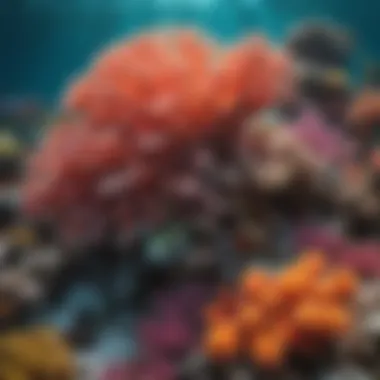
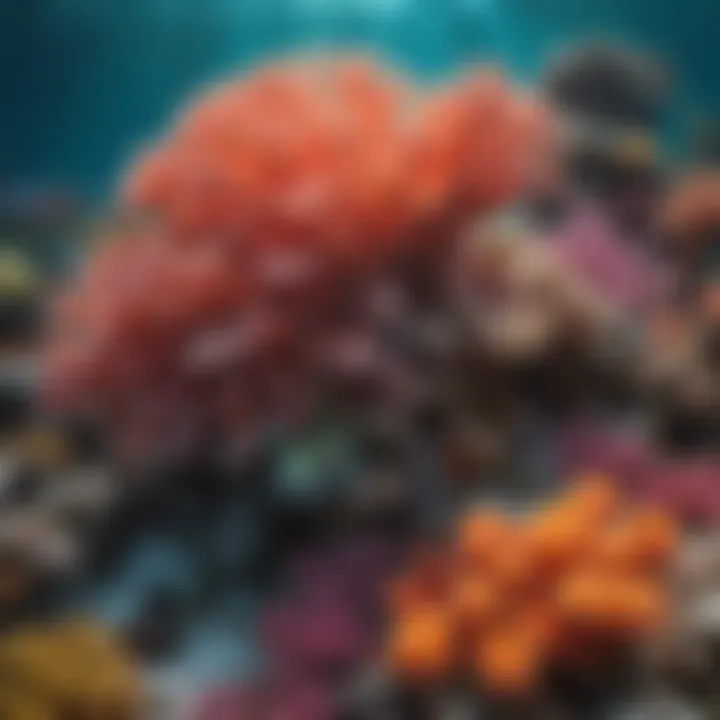
Intro
The reef cushion coast represents a unique tapestry woven from natural beauty and ecological significance. This coastal region, often overlooked by casual observers, serves as a vital artery for many marine species. Beneath the waves, it’s not just a playground for outdoor adventurers; it’s a delicate balance of life teetering against various environmental challenges. Understanding this ecosystem is essential for enthusiasts of water sports, as well as for those just looking to appreciate the wonders of nature.
In this guide, we dive into the intricate layers of the reef cushion coast, exploring its geographical features, rich biodiversity, and the constant threats it faces. Recognizing the role of local communities in conservation efforts will convey how essential their participation is in this ongoing mission. It’s time to navigate through the depths of this resilient ecosystem, appreciating not only its recreational value but also its environmental importance.
With that in mind, let’s delve into the techniques and skills that enthusiasts can adopt to cherish and protect this remarkable region.
Techniques and Skills
Fundamental Techniques for Beginners
When starting out in any watersport, knowledge is your best ally. For those engaging with the reef cushion coast, understanding its currents and tides can be the difference between a delightful adventure and a one-way ticket to trouble. Key techniques include:
- Basic Navigation: Comprehending local maps and using a compass can steer you clear of the rocky patches that dot the area.
- Wildlife Identification: Familiarizing oneself with local marine life not only heightens appreciation but also fosters respect for these creatures.
- Environmental Awareness: Clean practices like not disturbing coral reefs or collecting shells contribute to preserving this delicate habitat.
Starting with these skills can lay a sturdy foundation for your future water-based endeavors.
Advanced Skills for Experienced Athletes
Once you’ve grasped the basics, it’s time to tackle advanced techniques that can elevate your experience on the water. These skills not only enhance performance but also promote safety amongst fellow adventurers. Consider the following:
- Rescue Techniques: Knowing how to execute a proper rescue for yourself or others can save lives in emergencies.
- Advanced Flora and Fauna Knowledge: Understanding seasonal migrations of fish or the breeding habits of marine life can change your approach to each outing.
- Carbon Footprint Consideration: Engaging in eco-friendly practices, such as using biodegradable products and minimizing fuel consumption, is crucial in safeguarding the fragile ecosystem of the reef cushion coast.
Embarking on the water with these skills prepares you not just as a participant but as a steward of the environment.
Safety and Gear
Essential Safety Measures in Watersports
As with any outdoor activity, prioritizing safety is non-negotiable. Here are some fundamental measures:
- Always Wear a Life Jacket: No matter your skill level, ensure your life jacket is appropriately fitted.
- Notify Someone: Before heading out, inform a friend or family member about your plans and estimated return time.
- Check Weather Conditions: Always stay updated on local weather reports to avoid sudden storms or poor conditions.
Taking these precautions ensures both fun and safety are interwoven into every adventure.
Gear Reviews and Recommendations
Choosing the right gear can significantly impact your experience on the reef cushion coast. Here are some standout recommendations that cater to various needs:
- Paddleboards by Red Paddle Co: Their inflatable boards, known for durability, are excellent for navigating smaller inlets with ease.
- Snorkeling Gear from Cressi: Renowned for comfort and visibility, Cressi masks ensure you don’t miss out on vibrant underwater life.
- Wetsuits by Xcel: The right wetsuit not only helps you stay warm but adds an extra layer of buoyancy, a must when in colder waters.
Investing in quality gear enhances both performance and enjoyment, ensuring you’re well-equipped to tackle the challenges of the reef cushion coast’s waters.
Lastly, take the time to understand the delicate balance of this ecosystem. Your adventures can serve as a bridge between exploration and conservation, helping to protect this treasure for generations to come.
Understanding the Reef Cushion Coast
Understanding the reef cushion coast is akin to pulling back the curtain on a spectacular show unfolding in nature. This coastal area isn’t just a stretch of sand and sea; it's a bustling hub of marine activity and ecological significance. Comprehending its intricacies sheds light on how various elements interplay to sustain life and maintain the delicate balance of this ecosystem. For those who enjoy outdoor adventures, exploring this region offers not only recreation but also an invaluable opportunity to witness and appreciate nature's connected tapestry.
Defining the Reef Cushion Coast
The term "reef cushion coast" refers to coastal regions where coral reefs thrive, gently sloping into shallow waters, often cradling a variety of habitats like mangroves and seagrass meadows. It's a geographical concept, but it also embodies a vibrant ecological community teeming with life. These areas play a crucial role in protecting coastlines from erosion while providing a nursery ground for numerous marine species. In essence, the reef cushion coast is more than just a term; it's a lifeline for both marine and terrestrial organisms.
Geographical Characteristics
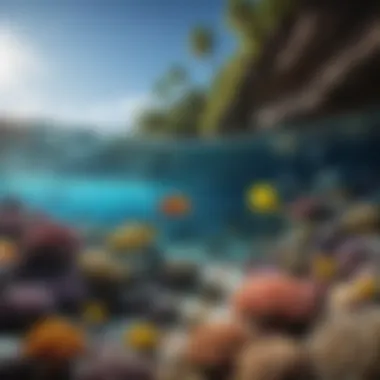
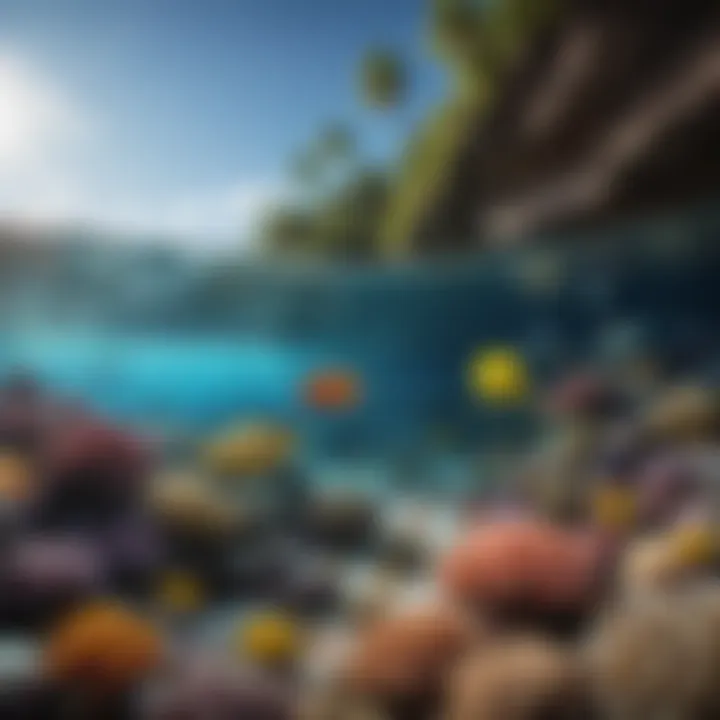
The geographical characteristics of the reef cushion coast are fascinating. Typically, these coasts feature a blend of sandy beaches, rocky outcrops, and intricate coral formations. The land rises and falls gently, creating a smooth transition from the shoreline to deeper waters. This gradual slope is essential as it houses various marine habitats, making it a hot spot for biodiversity. Features such as lagoons, tidal flats, and barrier islands often accompany these coastal regions, creating a dynamic environment for organisms to flourish.
"The blend of land and sea at the reef cushion coast creates an intricate mosaic that supports a multitude of life."
Climate and Weather Patterns
The climate of the reef cushion coast significantly impacts its ecology. Generally, these regions have a tropical or subtropical climate influenced by ocean currents. This can lead to warm waters, ideal for coral growth and marine life activity. Seasonal variations, like monsoon rains or dry spells, affect salinity and nutrient levels in the water, which in turn influences species distribution. For instance, during wet seasons, increased rainfall can lead to nutrient-rich runoff which boosts phytoplankton growth, benefiting the entire food web.
Various weather patterns influence the area as well. Tropical storms can occasionally wreak havoc but also play a role in shaping the landscape by redistributing sediments and creating new habitats. Understanding these patterns helps water sports enthusiasts plan their activities while being mindful of environmental impacts.
Biodiversity in the Reef Cushion Region
Biodiversity in the Reef Cushion Region represents a complex web of life that is critical for the overall health of the ecosystem. It refers to the variety of life forms, the genetic diversity within those species, and the intricate ecosystems that they inhabit. This richness is not only a remarkable natural phenomenon but also offers numerous benefits to humanity and the surrounding marine environment. When we think about how fisheries depend on this biodiversity for sustainable catches or how tourism thrives through vibrant coral landscapes, we begin to grasp the layer of significance it entails.
Coral Species Found in the Reef
Corals are the building blocks of the Reef Cushion coast. The region boasts a tapestry of coral species, each contributing to the overall structure and health of the marine ecosystem. Among the notable corals, staghorn coral and brain coral stand out for their distinct appearances and roles.
Staghorn coral, known for its branching structure, provides essential habitats for numerous fish species. This type of coral is particularly sensitive to environmental shifts, making its health a vital indicator of broader ecological changes. In contrast, brain coral, with its unique, round formation resembling a brain, offers a sturdy base for marine organisms to thrive. These coral species not only support marine life but also contribute to shoreline protection by mitigating wave energy.
Marine Life Diversity
The diversity of marine life in this region is astonishing. From the brightly colored clownfish hiding in anemones to the graceful sea turtles gliding through the water, each creature plays a role in the marine ecosystem. This diversity has far-reaching implications. For instance, fish species contribute to the balance of the ecosystem by controlling algae growth and maintaining the health of the reef.
The presence of various species also supports local fisheries, thus sustaining livelihoods. Moreover, healthy ecosystems enhance the area’s appeal for recreational activities such as snorkeling and scuba diving. As water sports enthusiasts often seek vibrant marine life, the richness of biodiversity becomes a crucial element for local tourism.
Importance of Mangroves and Seagrasses
Mangroves and seagrasses are often the unsung heroes of coastal ecosystems, yet their importance is profound. Mangrove forests act as nurseries for many marine species, providing shelter for juvenile fish while stabilizing coastlines against erosion. These trees can filter pollutants, enhancing water quality and fostering healthier marine habitats.
Similarly, seagrasses form an essential part of the ecosystem. They serve as feeding grounds for a variety of marine life, including manatees and certain fish species. Seagrasses also support life at the microbial level, which further contributes to nutrient cycling. In turn, these ecosystems promote a vibrant marine environment that benefits both nature and humans.
Endangered Species and Conservation Status
Among the dazzling array of creatures residing in the Reef Cushion Region, some species are endangered, making conservation efforts increasingly critical. The hawksbill turtle, for example, once abundant, faces threats from habitat loss and illegal poaching. Conservation statuses often reflect broader environmental trends, indicating urgent need for protective measures.
Organizations and local communities are working hand in hand to mitigate threats facing these endangered species. Conservation efforts include habitat restoration, stricter regulations on fishing practices, and educational campaigns to reduce plastic usage. It’s imperative that these initiatives continue, as they are fundamental to sustaining not only the tangible beauty of this marine habitat but the intricate life it supports.
"Protecting our reefs is not just about preserving beauty; it’s about ensuring future generations can enjoy and benefit from these ecosystems."
This multilayered narrative emphasizes that biodiversity thrives through interconnectedness. Each species, from the smallest plankton to the most majestic marine mammals, plays its role in the flourishing symphony of life that defines the Reef Cushion coast.
Human Interaction with the Reef Cushion Coast
Human interaction with the Reef Cushion Coast shapes not just the ecology but also the culture of the region. This interaction is a double-edged sword, fostering a spiritual connection to nature while also putting immense pressure on this delicate ecosystem. Understanding these interactions helps in recognizing both the vibrant experiences offered by this coastal environment and the responsibility that comes with them.
Historical Significance of Coastal Cultures
Throughout history, the coastal cultures thriving along the Reef Cushion Coast have demonstrated a profound relationship with the sea. Indigenous peoples utilized the coastline's natural bounty for sustenance, incorporating fish, shellfish, and sea plants into their daily lives. Their knowledge of the tides, currents, and seasonal fluctuations reflects a deep understanding of maritime rhythms.
The stories passed down through generations speak of creation, survival, and changes in the world.
- Artisanal Practices: Traditional fishing methods, like using nets made from local materials, showcase ingenuity that respects both the environment and the waters.
- Spiritual Connections: Many coastal cultures revere the ocean as a source of life, embedding rituals and beliefs centered around marine entities into their cultural fabric.
This connection laid the groundwork for modern efforts in conservation, as these communities are often the first to recognize changes in their environment. The depth of their history highlights not only a rich heritage but also an enduring respect for the marine ecosystem.
Recreational Activities and Watersports
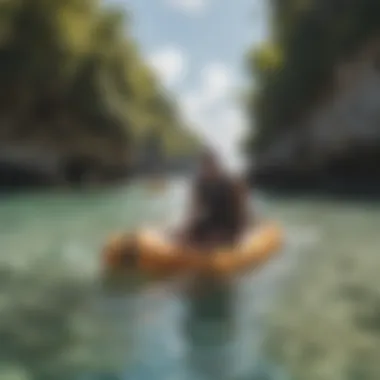

The Reef Cushion Coast has become a playground for watersport enthusiasts, drawing people who seek adventure and leisure alike. Whether it's the rush of windsurfing on turquoise waters, the tranquility of kayaking through mangroves, or diving into enchanting coral reefs, there is no shortage of activities.
- Snorkeling and Scuba Diving: These activities open the door to breathtaking marine life. Divers often marvel at the sights of vibrant coral formations and the playful antics of fish, drawing more attention to conservation efforts to protect these habitats.
- Kayaking: This serves both as a peaceful activity and a means to explore inaccessible areas. Paddling through serene estuaries reveals a world filled with curious wildlife, from crabs scuttling along the shore to birds nesting among the mangroves.
- Surfing: The swell generated by offshore winds offers waves that surfers chase relentlessly. Yet, surfers also play a critical role in advocating for clean oceans, often participating in beach clean-ups and awareness campaigns.
While these recreational activities boost local economies, they also necessitate responsible practices to ensure these landscapes endure for future generations.
Impact of Tourism on Marine Environments
Tourism presents both opportunities and challenges for the Reef Cushion Coast. With its stunning landscapes and rich biodiversity, it attracts visitors from all corners of the globe. However, the influx of tourists introduces pressures that can be detrimental to marine environments and local communities.
- Environmental Degradation: Increased boat traffic and the rise of coastal developments can lead to habitat destruction. Coral reefs, in particular, suffer from physical damage and pollution.
- Resource Strain: Local resources may become overutilized as tourism grows, placing additional pressure on fishing stocks and fresh water supplies.
- Awareness and Action: On the brighter side, tourism can drive conservation initiatives. More visitors mean more calls for environmental protection. Various organizations now offer educational programs to promote awareness about the ecological significance of the area.
"The balance between enjoying the Reef Cushion Coast and preserving its beauty for future generations lies in the hands of both tourists and locals."
In essence, the relationship between human activities and the Reef Cushion Coast is intricate and significant. Understanding these connections can aid in fostering more sustainable practices, ensuring that both nature and culture thrive in harmony.
Challenges Facing the Reef Cushion Coast
As we delve into the myriad challenges that plague the Reef Cushion Coast, it's imperative to recognize how these obstacles not only threaten the ecosystem but also the recreational pursuits that hinge on its vitality. From water sports enthusiasts seeking adventure to biodiversity advocates working tirelessly for conservation, the implications of these struggles reverberate through various facets of our interaction with this precious coastal habitat. Understanding these challenges is essential for fostering awareness and encouraging collective action in the face of mounting pressures.
Climate Change Impacts
The impacts of climate change manifest ominously along the Reef Cushion Coast. With rising sea temperatures and increasingly unpredictable weather patterns, the resident species and their habitats face significant strain. Coral bleaching, a phenomenon where corals expel their symbiotic algae, disrupts the delicate balance of marine life. When temperatures heat up, it spells trouble not only for the coral but for the entire marine community that relies on this vital structure for shelter and sustenance.
Furthermore, increased ocean acidification weakens coral skeletons and other calcareous organisms, rendering them more susceptible to damage. This sets off a domino effect, leading to decreased fish populations and the decline of associated ecosystems. The frequency and severity of storms also pose a grave risk, altering coastal landscapes and contributing to erosion, thereby exacerbating habitat loss for those species that thrive on stability.
Pollution and Marine Debris
Pollution, a blight on the pristine nature of the Reef Cushion Coast, takes many forms, with plastic debris being one of the most visible offenders. From single-use plastics trailing into the waves to hidden microplastics that infiltrate marine food webs, the ramifications of human activity are far-reaching. Marine life, from turtles to seabirds, often mistakenly ingest plastic, leading to fatal consequences.
Additionally, nutrient runoff from agriculture and urban areas introduces excess nitrogen and phosphorus into the waters. This can trigger harmful algal blooms, which deplete oxygen levels, harming fish and other aquatic lives. Whether through discarded fishing gear or litter, the stressors inflicted by pollution severely impede the natural beauty and health of the reef environment—truly a call to action for us all.
Overfishing and Its Consequences
Overfishing is yet another critical issue facing the Reef Cushion Coast. When fish populations are continuously harvested beyond their capacity to regenerate, it disrupts the ecological balance. Species that once thrived in abundance can experience stark declines, with predators and prey dynamics taking a heavy hit. For example, if the population of herbivorous fish dwindles due to overfishing, it can lead to unchecked algae growth on coral reefs, smothering them and stifling their recovery.
This situation doesn't just impact the species involved; it reverberates through the local economies dependent on fishing and tourism. The loss of biodiversity threatens not just the ecosystem but also livelihoods that rely on a rich marine environment. Thus, addressing overfishing is crucial not only for restoring ecological integrity, but also for ensuring the long-term prosperity of coastal communities that look to these waters for sustenance and economic activity.
"The delicate balance of marine life is under siege, and it is our moral obligation to protect this irreplaceable treasure."
In summary, the challenges facing the Reef Cushion Coast are significant and multifaceted. Climate change, pollution, and overfishing not only jeopardize the ecological health of this vibrant region but also affect those drawn to its waters for recreation and livelihood. Safeguarding this resilient ecosystem requires concerted efforts to combat these threats and foster a deeper understanding of our role in nurturing and preserving marine environments.
Conservation Efforts and Initiatives
Conservation is not just a buzzword when discussing the Reef Cushion Coast; it’s an urgent necessity. This coastal area teems with life, but it also faces significant threats from various human activities and climate changes. Thus, robust conservation efforts and initiatives play an essential role in sustaining this ecosystem. The benefits extend beyond merely protecting marine species; they also encompass economic advantages and the preservation of natural beauty, which both locals and tourists cherish.
Local and Global Conservation Programs
Local and global conservation programs are critical in addressing the issues facing the Reef Cushion Coast. Various organizations, both big and small, engage in efforts to protect this unique habitat. Locally, initiatives such as beach cleanups and biodiversity workshops aim to educate and empower the community to take better care of their environment. Global programs, on the other hand, often provide the much-needed funding and resources necessary for large-scale conservation projects.
For example, organizations like the Coral Triangle Initiative promote sustainable practices among local fisheries to protect coral reefs. They work closely with communities to manage resources sustainably and mitigate overfishing. Programs that combine both local knowledge and global scientific resources are often more effective, as they take into account the specific needs and dynamics of the region.
Community Involvement in Conservation
Community involvement proves to be the backbone of successful conservation efforts. When local residents appreciate and understand the value of their natural surroundings, they become its staunchest defenders. Local schools often introduce educational programs aimed at nurturing a sense of responsibility toward the environment among the younger generation. Furthermore, workshops that highlight the importance of the reef ecosystem can foster a commitment to sustainable practices.
In addition, volunteer programs that allow community members to participate in conservation activities not only provide immediate benefits for the environment but also forge a deeper connection between the locals and their natural resources. This connection is vital. Once people see the tangible benefits of a healthy reef, they are likely to invest time and effort into preserving it.
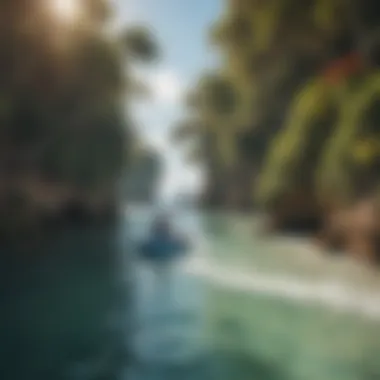
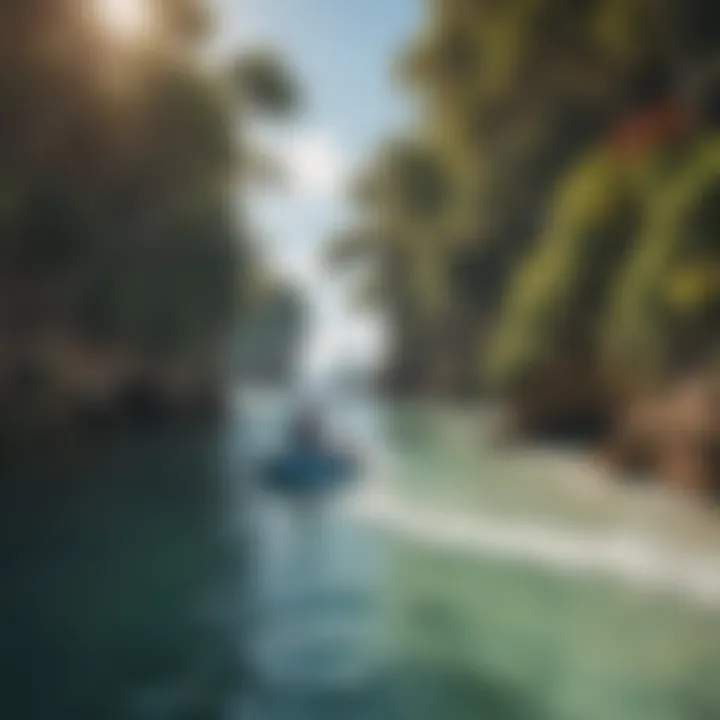
"It's not just about saving fish; it's about saving a way of life."
Ecotourism as a Conservation Tool
Ecotourism serves as another essential piece of the conservation puzzle. By promoting responsible travel to natural areas, ecotourism not only conserves the environment but also improves the well-being of local communities. Here, visitors can engage in activities such as snorkeling or kayaking that respect the underwater ecosystem while generating revenue that benefits conservation initiatives.
This type of tourism encourages local businesses to adopt sustainable practices that would minimize their environmental footprint. Moreover, when tourists actively participate in conservation-related activities—like guided beach cleanups or coral restoration projects—they contribute to the protection of the environment in a meaningful way.
In summary, the relationship between conservation efforts and community engagement forms a vital circle. Programs and initiatives that blend local participation with global support can indeed build resilience within the delicate ecosystem of the Reef Cushion Coast, ensuring that future generations can experience its beauty and diversity.
The Future of the Reef Cushion Coast
The future of the Reef Cushion Coast stands as a critical concern not just for local residents but for marine enthusiasts and environmentalists alike. This region, with its vibrant ecosystems and unique biodiversity, faces an uphill battle against various environmental strains. A thoughtful approach to its preservation can ensure that future generations experience its beauty and ecological significance.
Sustainable Practices for Preservation
Engaging in sustainable practices is paramount for the ongoing health of the Reef Cushion Coast. These practices integrate environmental stewardship into daily activities, ensuring that tourism and development do not come at a cost to the delicate marine life. Popular methods include:
- Responsible fishing: Implementing catch limits and promoting catch-and-release fishing can help preserve fish populations.
- Eco-friendly tourism: Tour operators are increasingly adopting guidelines that minimize environmental footprints. Travelers can contribute by selecting sustainable businesses.
- Habitat restoration: Community-led efforts in planting seagrasses and restoring mangroves can support marine ecosystems effectively.
By actively supporting these practices, we can assert that the marine environment withstands the tests of time, providing benefits not only to nature but also to economic sectors that depend on it.
Innovations in Marine Conservation
The field of marine conservation is blossoming with innovative techniques aimed at safeguarding environments like the Reef Cushion Coast. Some noteworthy approaches include:
- Use of drones for monitoring: Unmanned aerial vehicles equipped with surveillance technology can systematically map reef health and report illegal activities.
- Genetic research on coral: Scientists are exploring gene editing to enhance coral resilience against climate change impacts, potentially revolutionizing reef restoration.
- Artificial intelligence in data analysis: AI can process complex data related to marine biodiversity, helping researchers to identify trends and inform conservation strategies.
Each of these innovations not only addresses current challenges but also paves the way for a more robust framework for precaution in marine stewardship.
Long-term Goals for Environmental Health
The ultimate aim of any conservation effort must be the long-term environmental health of the Reef Cushion Coast. To achieve this, a multi-faceted approach is required:
- Establish marine protected areas: Creating zones where human activity is limited can significantly boost marine biodiversity and ecosystem recovery.
- Promote education and awareness: Fostering a strong knowledge base among locals and visitors about the importance of conservation can inspire more people to take part.
- Collaboration with scientific communities: Engaging researchers in long-term studies provides invaluable data that can shape effective conservation policies.
- Strengthening community resilience: Training programs aimed at building local capacity for sustainable practices ensure that communities can cope with environmental changes.
"Protecting the Reef Cushion Coast is not just about preserving beauty, it's about securing the ecosystem’s balance for our future."
By anchoring these long-term objectives into every conservation initiative, the Reef Cushion Coast can prosper as a resilient ecosystem, providing both ecological and recreational value for years to come.
Finale: The Value of the Reef Cushion Coast
The Reef Cushion Coast serves as a microcosm of ecological resilience and vibrancy. This breathtaking region not only supports an impressive array of marine life but also functions as a cornerstone for sustainable recreational activities. Understanding its multifaceted role enables us to appreciate the subtleties of its ecosystems and fosters a commitment to their preservation.
Summary of Key Insights
The Reef Cushion Coast is marked by distinct geographical features and a rich tapestry of biodiversity. From lush mangroves to vibrant coral reefs, the coast is a sanctuary for numerous species that rely on its unique environment. Key points explored include:
- Biodiversity: The complex interplay of coral species and marine life offers critical insights into the health of marine ecosystems.
- Human Interaction: The history and modern development of human activities emphasize both the cultural significance and potential threats to this habitat.
- Challenges Facing the Ecosystem: Issues like climate change, pollution, and overfishing highlight the urgent need for protective measures.
- Conservation Efforts: Local and global initiatives showcase community involvement and innovative strategies aimed at bolstering resilience.
These insights underscore the interdependence between human activities and natural ecosystems, driving home the importance of sustainable practices.
Call to Action for Readers
As stewards of our environment, it’s essential for readers to reflect on their role in safeguarding the Reef Cushion Coast. Here are practical ways to contribute:
- Educate Yourself and Others: Stay informed about local marine environments and share knowledge with others to foster awareness.
- Participate in Conservation Activities: Engage with local conservation programs, whether through volunteering, donations, or advocacy.
- Practice Sustainable Tourism: When visiting coastal regions, respect wildlife and natural habitats. Opt for eco-friendly activities and support businesses that prioritize sustainability.
- Limit Pollution: Reduce the usage of plastics and avoid single-use items to help protect marine environments from debris.
In summation, the Reef Cushion Coast is a jewel worth cherishing. By embracing our collective responsibility, we can ensure the health of this vital ecosystem for generations to come.
"The health of our oceans is paramount. When we protect marine biodiversity, we protect our future."
Engagement, education, and proactive measures will help us triumph over the challenges facing the Reef Cushion Coast while celebrating its unique ecological significance.















